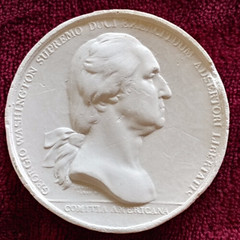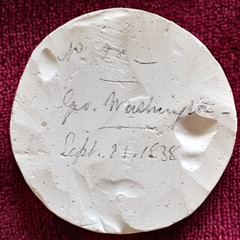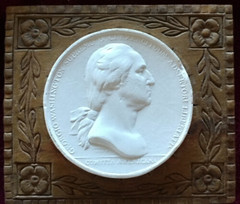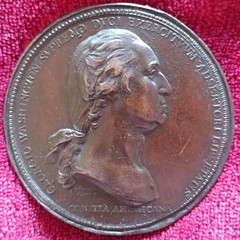
PREV ARTICLE
NEXT ARTICLE
FULL ISSUE
PREV FULL ISSUE
ANOTHER WASHINGTON BEFORE BOSTON MEDAL PLASTERDavid Hirsch of Arroyo Grande, California submitted these notes on a Washington Before Boston medal plaster in his possession. Thank you! -Editor
I was taken back a bit when I saw the discussion in this week's E-Sylum about the plaster of the rejected obverse die for the Washington Before Boston Medal for a couple of reasons. First, I have one. I am enclosing a couple of pictures. I don't have a caliper, but it looks like it's about 66 mm across.   I bought it on eBay in July, 1999 for $50. I have been aware that it was the rejected obverse, and have puzzled over how it could have been made since the only known pieces are the shells. It was not included in the sale of my Washingtonia by Joe Levine in May, 2011 (Presidential Coin and Antique's Auction 81). That auction did include my shell of the rejected obverse die (B 47X, lot 141). I actually had bought my shell on eBay as well. When I saw the shell listed in February, 2006 I immediately recognized it for what it was. I was the only bidder and bought it for a winning bid of $5, plus another $5.85 for shipping! It sold for $2350 in Joe's auction. I don't recall if I had mentioned the plaster piece to Joe or not, to be honest. The back of my plaster is also interesting. It has written in pencil "No. 98 geo. Washington. Sept. 21, 1838" Does this provide a clue? Also, the one in the E-Sylum does not appear to have "Du Vivier Paris" under the bust, while mine does (although it might just be the picture...). The other reason I was surprised to see the discussion about the plaster piece was that last month, while on a trip to New Hampshire, my wife and I visited the Saint-Gaudens National Historic Site, where we saw his plaster maquettes of the $20 gold pieces and other medals. At the time, it reminded me of my plaster of the rejected Washington Before Boston obverse, which I really had forgotten about. Also, for what its worth, mine came with a small wooden base. It is not attached to the base in any manner.   Anne Bentley adds: I could be wrong, but I would guess that the carved base was something commissioned at some point by an owner. Somehow it doesn’t seem like it would have been an official mint production. David responds: Perhaps it was part of a collection of plaster reproductions and the wooden base was used as a way to display them. That might also explain the number on the back. But that still begs the question of how it could have been made, given that the rejected obverse is only known in the extremely rare uniface shells, and no known medals were struck... Lead filled shell obverse with a beaded border " 'George Fuld said: 'John Adams thinks this is possibly an official development piece but more likely a private attempt to improve the medal. I agree.' Dick Johnson said he believed it to be a 'home made cast' and was 'worthless' ". I bought the beaded border piece from Chuck Kirtley in March, 1993. It had originally been scheduled as a lot in a floor sale at a hotel in New York, but this hotel was impacted by the 1993 World Trade Center bombing and the sale was cancelled, so Chuck included it as a lot in one of his mail bid/phone sales. I also have notes from my visits to the Long Beach Coin Shows in June and October, 1995. In June I took this piece to show around. My notes say “Alan Weinberg and Jack Collins got excited— thought might be ‘pattern’. Weinberg wanted to buy it—Tony Terranova thought it might be ‘contemporary cast’ used on things like boxes as decorative item.” My notes from the October 1995 show say that Jack Collins “spoke a lot about it…and what an intriguing piece it is” Also that he had “Told Steve Tannenbaum it may be a pattern.” My notes conclude by saying that Jack “…went on a lot about it, also that Alan Weinberg spoke a lot about it and that Jack even asked if Weinberg had pestered me to buy it…” Looking forward to hearing any thoughts about yet another rejected obverse plaster, as well as the beaded border piece. Fun stuff... We'd be curious to hear what readers have to say about this. Thanks. -Editor
To read the earlier E-Sylum article, see:  Wayne Homren, Editor The Numismatic Bibliomania Society is a non-profit organization promoting numismatic literature. See our web site at coinbooks.org. To submit items for publication in The E-Sylum, write to the Editor at this address: whomren@gmail.com To subscribe go to: https://my.binhost.com/lists/listinfo/esylum All Rights Reserved. NBS Home Page Contact the NBS webmaster 
|
